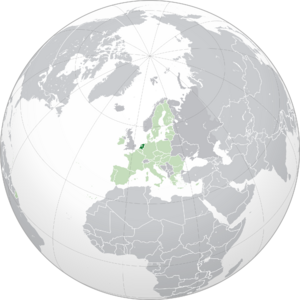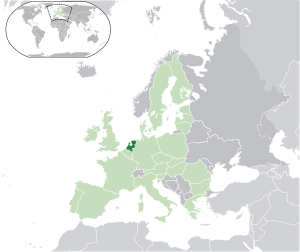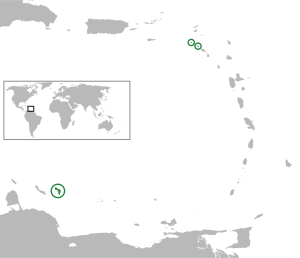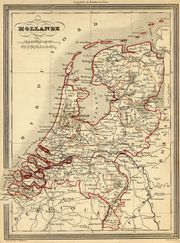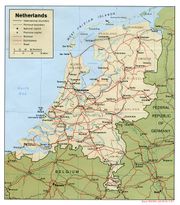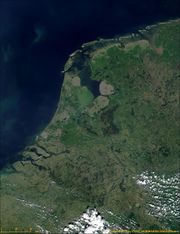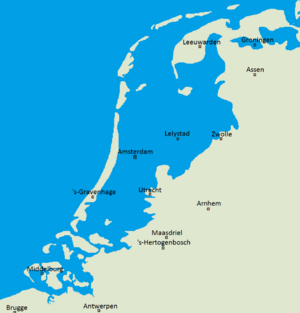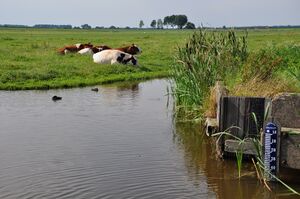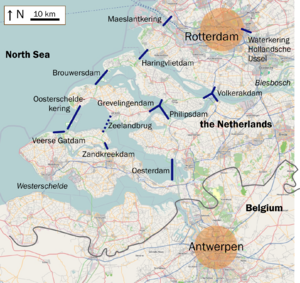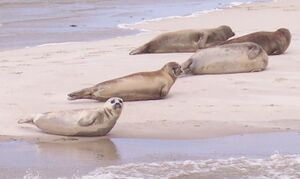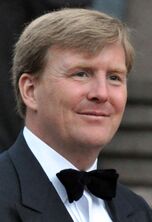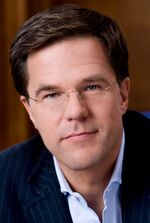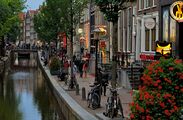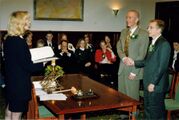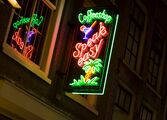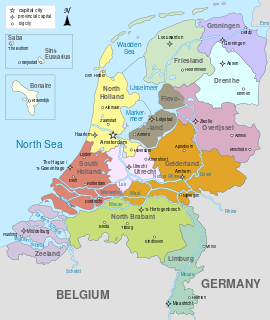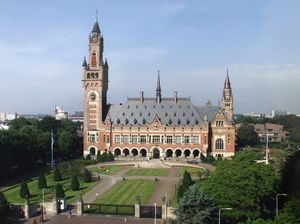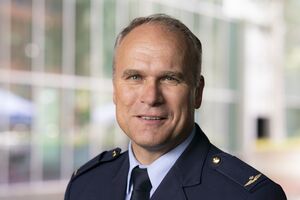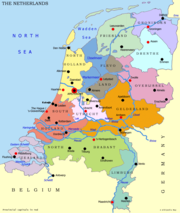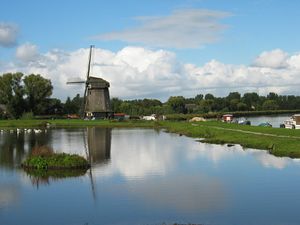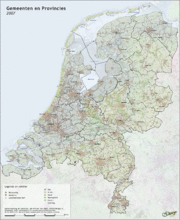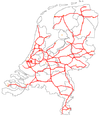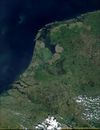هولندا
Netherlands Nederland (هولندية) | |
|---|---|
| Motto: | |
| Anthem: ويلهلموس (هولندية) (إنگليزية: "William of Nassau") | |
موقع هولندا (أخضر داكن) – in أوروپا (أخضر & الرمادي الداكن) | |
| دولة ذات سيادة | مملكة هولندا |
| قبل الاستقلال | هولندا الإسپانية |
| قانون النبذ | 26 يوليو 1581 |
| سلام مونستر | 30 يناير 1648 |
| تأسيس المملكة | 16 مارس 1815 |
| يوم التحرير | 5 مايو 1945 |
| ميثاق المملكة | 15 ديسمبر 1954 |
| إعادة تنظيم الكاريبي | 10 أكتوبر 2010 |
| العاصمة | أمستردام[أ] 52°22′N 4°53′E / 52.367°N 4.883°E |
| مقر الحكومة | لاهاي[أ] |
| أكبر مدينة | العاصمة |
| اللغات الرسمية | الهولندية |
اللغات المعترَف بها | |
| الجماعات العرقية (2020) | |
| الدين (2020) |
|
| صفة المواطن | هولندي Dutch |
| الحكومة | ملكية دستورية مركزية برلمانية |
• العاهل | ويلم-ألكسندر |
| مارك روته | |
| Legislature | مجلس الأعيان |
| مجلس الشيوخ | |
| مجلس النواب | |
| البرلمان الأوروپي | |
| 26 مقعد | |
| المساحة | |
• Total | 41,850 km2 (16,160 sq mi) (131st) |
• Water (%) | 18.41[5] |
| أعلى منسوب | 887 m (2٬910 ft) |
| التعداد | |
• 10 مايو 2024 estimate | |
• 2011 census | 16,655,799[7] |
• Density | 423/km2 (1,095.6/sq mi) (16th) |
| GDP (PPP) | 2022 estimate |
• Total | ▲ $1.2 trillion [8] (27th) |
• Per capita | ▲ $68,572[8] (13th) |
| GDP (nominal) | 2022 estimate |
• Total | ▲ $1.01 trillion[8] (19th) |
• Per capita | ▲ $57,836[8] (13th) |
| Gini (2020) | ▲ 28.2[9] low |
| HDI (2021) | very high · 10th |
| العملة |
|
| Time zone | |
• Summer (DST) | |
| Date format | dd-mm-yyyy |
| Mains electricity | 230 V–50 Hz |
| Driving side | right |
| Calling code | +31, +599[خ] |
| ISO 3166 code | NL |
| Internet TLD | .nl, .bq[د] |
هولندا أو البلدان المنخفضة (هولندية: Nederland [ˈneːdərlɑnt] (![]() استمع))، بشكل غير رسمي هولندا,[12][13][14] هي الكيان الدستوري 12 مقاطعة، تقع شمال غرب أوروپا وثلاث جزر في الكاريبي. الجزء الأوروپي من هولندا يحده من الشمال والغرب بحر الشمال، بلجيكا من الجنوب، وألمانيا من الشرق، وتشترك بحدود بحرية[15] مع بلجيكا، ألمانيا والمملكة المتحدة. تتمتع هولندا بنظام ديمقراطي برلماني في ظل دولة موحدة. اصمتها مدينة أمستردام ومجلس حكومة في لاهاي.[16] المملكة هي إحدى دول البنلوكس و الاتحاد الاوروبي. هولندا هي موطن الرسامين العالمين فان كوخ ورامبرانت، كما أنها موطن أزهار الخُزامى (التوليب) و العديد من أصناف الجبن المعروفة عالمياً. اللغة الرسمية للبلاد هي الهولندية، مع الفريزية الغربية كلغة رسمية ثانوية في مقاطعة فريزلاند.[1] الساكسونية السفلى الهولندية و الليمبورگش هما لغتان إقليميتان معترف بهما، بينما لغة الإشارة الهولندية وسنته روماني واليديش هي لغات أقليات غير إقليمية معترف بها.[1][2] الهولندية والإنگليزية والپاپيامنتو هي لغات رسمية في الأراضي الكاريبية.[1]
استمع))، بشكل غير رسمي هولندا,[12][13][14] هي الكيان الدستوري 12 مقاطعة، تقع شمال غرب أوروپا وثلاث جزر في الكاريبي. الجزء الأوروپي من هولندا يحده من الشمال والغرب بحر الشمال، بلجيكا من الجنوب، وألمانيا من الشرق، وتشترك بحدود بحرية[15] مع بلجيكا، ألمانيا والمملكة المتحدة. تتمتع هولندا بنظام ديمقراطي برلماني في ظل دولة موحدة. اصمتها مدينة أمستردام ومجلس حكومة في لاهاي.[16] المملكة هي إحدى دول البنلوكس و الاتحاد الاوروبي. هولندا هي موطن الرسامين العالمين فان كوخ ورامبرانت، كما أنها موطن أزهار الخُزامى (التوليب) و العديد من أصناف الجبن المعروفة عالمياً. اللغة الرسمية للبلاد هي الهولندية، مع الفريزية الغربية كلغة رسمية ثانوية في مقاطعة فريزلاند.[1] الساكسونية السفلى الهولندية و الليمبورگش هما لغتان إقليميتان معترف بهما، بينما لغة الإشارة الهولندية وسنته روماني واليديش هي لغات أقليات غير إقليمية معترف بها.[1][2] الهولندية والإنگليزية والپاپيامنتو هي لغات رسمية في الأراضي الكاريبية.[1]
أكبر أربع مدن في هولندا هي أمستردام و روتردام ولاهاي و أوترخت.[17] أمستردام هي أكبر المدن تعدادا والعاصمة الاسمية.[18] وتحتفظ لاهاي بمقر مجلس الأعيان ومجلس الوزراء و المحكمة العليا.[19] ميناء روتردام هو أزحم ميناء بحري في أوروپا.[20] سخيپول هو أزحم مطار في هولندا، وثالث أزحم مطار في أوروپا. هولنجا هي عضو مؤسس في الاتحاد الأوروپي ومنطقة اليورو وG10 والناتو وOECD و منظمة التجارة العالمية، كما أنها جزء من منطقة شنگن واتحاد بنلوكس الثلاثي. وتستضيف العديد من المنظمات الدولية والمحاكم الدولية، العديد منهم يتخذ من لاهاي مقراً.[21]
Netherlands literally means "lower countries" in reference to its low elevation and flat topography, with only about 50% of its land exceeding 1 m (3.3 ft) above sea level, and nearly 26% falling below sea level.[22] Most of the areas below sea level, known as polders, are the result of land reclamation that began in the 14th century.[23] In the Republican period, which began in 1588, the Netherlands entered a unique era of political, economic, and cultural greatness, ranked among the most powerful and influential in Europe and the world; this period is known as the Dutch Golden Age.[24] During this time, its trading companies, the Dutch East India Company and the Dutch West India Company, established colonies and trading posts all over the world.[25][26]
With a population of 17.7 million people, all living within a total area of 41,850 km2 (16,160 sq mi)—of which the land area is 33,500 km2 (12,900 sq mi)—the Netherlands is the 16th most densely populated country in the world and the second-most densely populated country in the European Union, with a density of 529 people per square kilometre (1,370 people/sq mi). Nevertheless, it is the world's second-largest exporter of food and agricultural products by value, owing to its fertile soil, mild climate, intensive agriculture, and inventiveness.[27][28][29]
The Netherlands has been a parliamentary constitutional monarchy with a unitary structure since 1848. The country has a tradition of pillarisation and a long record of social tolerance, having legalised abortion, prostitution and human euthanasia, along with maintaining a liberal drug policy. The Netherlands abolished the death penalty in Civil Law in 1870, though it was not completely removed until a new constitution was approved in 1983. The Netherlands allowed women's suffrage in 1919 and was the first country to legalise same-sex marriage in 2001. Its mixed-market advanced economy has the twelfth-highest per capita income globally.[30] The Netherlands ranks among the highest in international indices of press freedom,[31] economic freedom,[32] human development and quality of life, as well as happiness.[33][34]
. . . . . . . . . . . . . . . . . . . . . . . . . . . . . . . . . . . . . . . . . . . . . . . . . . . . . . . . . . . . . . . . . . . . . . . . . . . . . . . . . . . . . . . . . . . . . . . . . . . . . . . . . . . . . . . . . . . . . . . . . . . . . . . . . . . . . . . . . . . . . . . . . . . . . . . . . . . . . . . . . . . . . . . .
أصل الاسم
الأراضي الواطئة والبلاد المنخفضة
The region called the Low Countries (comprising Belgium, the Netherlands and Luxembourg) have the same toponymy. Place names with Neder, Nieder, Nedre, Nether, Lage(r) or Low(er) (in Germanic languages) and Bas or Inferior (in Romance languages) are in use in low-lying places all over Europe. In the case of the Low Countries / Netherlands the geographical location of the lower region has been more or less downstream and near the sea. The Romans made a distinction between the Roman provinces of downstream Germania Inferior (nowadays part of Belgium and the Netherlands) and upstream Germania Superior. The designation 'Low' returned in the 10th-century Duchy of Lower Lorraine, that covered much of the Low Countries.[35][36]
The Dukes of Burgundy used the term les pays de par deçà ("the lands over here") for the Low Countries.[37] Under Habsburg rule, Les pays de par deçà developed in pays d'embas ("lands down-here").[38] This was translated as Neder-landen in contemporary Dutch official documents.[39] From a regional point of view, Niderlant was also the area between the Meuse and the lower Rhine in the late Middle Ages. From the mid-sixteenth century, the "Low Countries" and the "Netherlands" lost their original deictic meaning. The Eighty Years' War (1568–1648) divided the Low Countries into an independent northern Dutch Republic and a Spanish-controlled Southern Netherlands.[بحاجة لمصدر]
In most Romance languages, the term "Low Countries" is used as the name for the Netherlands. In other languages, it is sometimes used to describe the Benelux countries.[بحاجة لمصدر]
هولندا و دتش
The Netherlands is informally referred to as Holland in various languages, including Dutch[40] and English. In other languages, Holland is the formal name for the Netherlands. Holland can also refer to a region within the Netherlands that consists of North and South Holland. Formerly these were a single province, and earlier the County of Holland, a remnant of the dissolved Frisian Kingdom that also included parts of present-day Utrecht. Following the decline of the Duchy of Brabant and the County of Flanders, Holland became the most economically and politically important county in the Low Countries region. The emphasis on Holland during the formation of the Dutch Republic, the Eighty Years' War, and the Anglo-Dutch Wars in the 16th, 17th, and 18th centuries, made Holland a pars pro toto for the entire country.[41][42]
The term Dutch is used as the demonymic and adjectival form of the Netherlands in the English language. The origins of the word go back to Proto-Germanic *þiudiskaz, Latinised into Theodiscus, meaning "popular" or "of the people"; akin to Old Dutch Dietsch, Old High German duitsch, and Old English þeodisc, all meaning "(of) the common (Germanic) people". At first, the English language used (the contemporary form of) Dutch to refer to any or all speakers of West Germanic languages. Gradually its meaning shifted to the West Germanic people they had most contact with, because of their geographical proximity and rivalry in trade and overseas territories. The derivative of the Proto-Germanic word *þiudiskaz in modern Dutch, Diets, can be found in Dutch literature as a poetic name for the Dutch people or language, and is considered archaic.[بحاجة لمصدر]
التاريخ
 مقالة مفصلة: تاريخ هولندا
مقالة مفصلة: تاريخ هولندا
وقعت الأراضي الهولندية و البلجيكية تحت يد آل هابسبورغ عام 1477. وحدت أراضي هولندا و بلجيكيا و اللوكسمبورغ تحت اسم الأراضي المنخفضة في عام 1579، اللتي كانت تُشكل الولايات الشمالية من الامبراطورية الاسبانية تحت حكم آل هابسبورغ. أُسست جمهورية الأراضي المنخفضة المتحدة عام 1581، بعد اعلان نفسها منسحبة من الاتحاد الاسباني. بعد سلسة من النزاعات تمكنت الأراضي المنخفضة من الحصول فعلياً على استقلالها في 1648. شهدت البلاد بعد ذلك عصراً ذهبياً اقتصادياً و ثقافياً في القرن السابع عشر، وصلت فيها مرتبة الدول العظمى. استعمرت فيه الأراضي المنخفضة بلدان في [آسيا]، أفريقيا و أمريكا اللاتينية، و سيطرت على كثير من الطرق الملاحية العالمية. أصبحت تعتمد تدريجياً في القرن الثامن عشر على جيرانها إلى أن وُحدت مع بلجيكا ،مرة أخرى، على اثر قرارات مؤتمر فيينا عام 1815 بعد انتهاء الحروب النابليونية تحت اسم مملكة الأراضي المنخفضة. نشبت خلافات على السطح بين الهولنديين و البلجيك بسبب اختلاف الثقافة و اللغة بينهم إلى أن بدأت بلجيكا عام 1830 كفاحها للاستقلال عن الأراضي المنخفضة. حصلت الأراضي المنخفضة على حدودها المعروفة اليوم عام 1839 بعد استقلال بلجيكا و اللوكسمبورغ نهائياً عنها.
اتبعت البلاد سياسة محافظة دينية منذ بداية القرن العشرين و حتى بعد نهاية الحرب العالمية الثانية. كما نهجت الأراضي المنخفضة سياسة الحياد في الحرب العالمية الأولى. غزت ألمانيا البلاد في عام 1940 ابان الحرب العالمية الثانية، لجأت الملكة وليامينا و أعضاء الحكومة إلى لندن. قام النازيون باعتقال و قمع الآلاف في السنوات القادمة. أعلنت الأراضي المنخفضة الحرب على اليابان عام 1941. احتل اليابانيون في العام المقبل جزر الهند الهولندية (أندونيسيا). انزل الحلفاء قواتهم عام 1944 في أرنهايم و تمكنوا من تحرير البلاد بغضون عام 1945. عادت العائلة الحاكمة و الحكومة إلى البلاد و وقعت اتفاقية البنلوكس للاعفاء الجمركي بين الأراضي المنخفضة، بلجيكا و اللوكسمبورغ، اللتي دخلت حيز التنفيذ في عام 1948، ثم أصبح لاحقاً اتحاداً اقتصادياً عام 1958. أودت أقوى عاصفة بحرية منذ القرن الخامس عشرعام 1953 بحياة المئات و تشريد الآلاف. دخلت الأراضي المنخفضة في سلسة من الاتفاقيات السياسية و الاقتصادية مع جيرانها الاوروبيين أولها كان عام 1951، عندما أُسست المجموعة الاوروبية للفحم و الحديد، اللتي كانت نواة الاتحاد الاوروبي. كما كان اتفاق ماسترخت اللذي وُقع في مدينة ماسترخت الهولندية عام 1992 كان أساس الاتحاد الاوروبي، اللذي دخل حيز التنفيذ في العام المقبل.
. . . . . . . . . . . . . . . . . . . . . . . . . . . . . . . . . . . . . . . . . . . . . . . . . . . . . . . . . . . . . . . . . . . . . . . . . . . . . . . . . . . . . . . . . . . . . . . . . . . . . . . . . . . . . . . . . . . . . . . . . . . . . . . . . . . . . . . . . . . . . . . . . . . . . . . . . . . . . . . . . . . . . . . .
الجغرافيا
 مقالة مفصلة: جغرافيا هولندا
مقالة مفصلة: جغرافيا هولندا
تبلغ مساحة هولندا (40,844 كم)، وتنقسم إلى 11 مقاطعة. تحدها ألمانيا من الشرق، وبلجيكا من الجنوب، وبحر الشمال من الغرب والشمال. تشغل أرضها القسم الغربي من السهل الأوروبي الشمالي حيث دلتوات أنهار الراين وماز وشيلد وفال. وتتكون الأرض من سهول منبسطة، ولقد استقطع الهولنديون قسماً من الاراضي الساحلية على حساب البحر، وذلك بإقامة السدود والحواجز، وحولت إلى أراضي زراعية. تم الحصول على مناطق كاملة كمقاطعة فليفولاند في هولندا من خلال ردم مياه البحر. حوالي خمس مساحة هولندا يتكون من الماء في شكل يحيرات وقنوات، وحوالي نصف أرضها أقل من مستوي سطح البحر ،وهذا القسم محمي بالسدود، وقد أنجزت عدة مشاريع لتجفيف المستنقعات والبحيرات المكتسبة من البحر ، وهناك مشروع عملاق هو مشروع الدلتا. ينتمي مناخ هولندا إلى مناخ غربي أوروبا، وليس هناك اختلافات واضحة في مناخها بسبب صغر مساحتها وانبساط أرضها، والشتاء بارد ويتساقط الثلج حوالي ثلاثين يوماً في فصل الشتاء ،والرياح الغربية هي السائدة، والصيف معتدل والمطر شتوي وصيفي ،ويزداد في الصيف، ولقد قل النبات الطبيعي في معظم الأراضي الهولندية، وذلك بسبب التوسع الزراعي، ولكن لاتزال توجد جزر من الغابات في النطاق الجنوبي والشرقي . يبلغ ارتفاع حوالي نصف أراضي المملكة أقل من متر واحد فوق سطح الأرض. أعلى ارتفاع هو جبل فالسربرگ اللذي يصل ارتفاعه إلى 321 متر. 18.41% من مساحة البلاد مغطاة بالمياه.
The European Netherlands is divided into north and south parts by the Rhine, the Waal, its main tributary branch, and the Meuse. In the past, these rivers functioned as a natural barrier between fiefdoms and hence historically created a cultural divide, as is evident in some phonetic traits that are recognisable on either side of what the Dutch call their "Great Rivers" (de Grote Rivieren). Another significant branch of the Rhine, the IJssel river, discharges into Lake IJssel, the former Zuiderzee ('southern sea'). Just like the previous, this river forms a linguistic divide: people to the northeast of this river speak Dutch Low Saxon dialects (except for the province of Friesland, which has its own language).[43]
الجيولوجيا
The modern Netherlands formed as a result of the interplay of the four main rivers (Rhine, Meuse, Schelde and IJssel) and the influence of the North Sea. The Netherlands is mostly composed of deltaic, coastal and eolian derived sediments during the Pleistocene glacial and interglacial periods.[بحاجة لمصدر]
Almost the entire west Netherlands is composed of the Rhine-Meuse river estuary, but human intervention greatly modified the natural processes at work. Most of the western Netherlands is below sea level due to the human process of turning standing bodies of water into usable land, a polder.[بحاجة لمصدر]
In the east of the Netherlands, remains are found of the last ice age, which ended approximately ten thousand years ago. As the continental ice sheet moved in from the north, it pushed moraine forward. The ice sheet halted as it covered the eastern half of the Netherlands. After the ice age ended, the moraine remained in the form of a long hill-line. The cities of Arnhem and Nijmegen are built upon these hills.[44]
الفيضانات
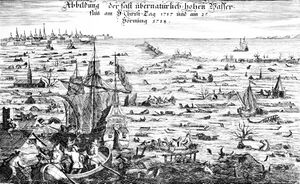
Over the centuries, the Dutch coastline has changed considerably as a result of natural disasters and human intervention.
On 14 December 1287, St. Lucia's flood affected the Netherlands and Germany, killing more than 50,000 people in one of the most destructive floods in recorded history.[45] The St. Elizabeth flood of 1421 and the mismanagement in its aftermath destroyed a newly reclaimed polder, replacing it with the 72 km2 (28 sq mi) Biesbosch tidal floodplains in the south-centre. The huge North Sea flood of early February 1953 caused the collapse of several dikes in the south-west of the Netherlands; more than 1,800 people drowned in the flood. The Dutch government subsequently instituted a large-scale programme, the "Delta Works", to protect the country against future flooding, which was completed over a period of more than thirty years.[بحاجة لمصدر]
The impact of disasters was, to an extent, increased through human activity. Relatively high-lying swampland was drained to be used as farmland. The drainage caused the fertile peat to contract and ground levels to drop, upon which groundwater levels were lowered to compensate for the drop in ground level, causing the underlying peat to contract further. Additionally, until the 19th-century peat was mined, dried, and used for fuel, further exacerbating the problem. Centuries of extensive and poorly controlled peat extraction lowered an already low land surface by several metres. Even in flooded areas, peat extraction continued through turf dredging.[بحاجة لمصدر]
Because of the flooding, farming was difficult, which encouraged foreign trade, the result of which was that the Dutch were involved in world affairs since the early 14th/15th century.[46]
To guard against floods, a series of defences against the water were contrived. In the first millennium AD, villages and farmhouses were built on man-made hills called terps. Later, these terps were connected by dikes. In the 12th century, local government agencies called "waterschappen" ("water boards") or "hoogheemraadschappen" ("high home councils") started to appear, whose job it was to maintain the water level and to protect a region from floods; these agencies continue to exist. As the ground level dropped, the dikes by necessity grew and merged into an integrated system. By the 13th century windmills had come into use to pump water out of areas below sea level. The windmills were later used to drain lakes, creating the famous polders.[47]
In 1932 the Afsluitdijk ("Closure Dike") was completed, blocking the former Zuiderzee (Southern Sea) from the North Sea and thus creating the IJsselmeer (IJssel Lake). It became part of the larger Zuiderzee Works in which four polders totalling 2,500 square kilometres (965 sq mi) were reclaimed from the sea.[48][49]
The Netherlands is one of the countries that may suffer most from climate change. Not only is the rising sea a problem, but erratic weather patterns may cause the rivers to overflow.[50][51][52]
. . . . . . . . . . . . . . . . . . . . . . . . . . . . . . . . . . . . . . . . . . . . . . . . . . . . . . . . . . . . . . . . . . . . . . . . . . . . . . . . . . . . . . . . . . . . . . . . . . . . . . . . . . . . . . . . . . . . . . . . . . . . . . . . . . . . . . . . . . . . . . . . . . . . . . . . . . . . . . . . . . . . . . . .
أعمال الدلتا
After the 1953 disaster, the Delta Works was constructed, which is a comprehensive set of civil works throughout the Dutch coast. The project started in 1958 and was largely completed in 1997 with the completion of the Maeslantkering. Since then, new projects have been periodically started to renovate and renew the Delta Works. The main goal of the Delta project was to reduce the risk of flooding in South Holland and Zeeland to once per 10,000 years (compared to once per 4000 years for the rest of the country). This was achieved by raising 3,000 km (1,900 mi) of outer sea-dikes and 10,000 km (6,200 mi) of the inner, canal, and river dikes, and by closing off the sea estuaries of the Zeeland province. New risk assessments occasionally show problems requiring additional Delta project dike reinforcements. The Delta project is considered by the American Society of Civil Engineers as one of the seven wonders of the modern world.[53]
It is anticipated that global warming in the 21st century will result in a rise in sea level. The Netherlands is actively preparing for a sea-level rise. A politically neutral Delta Commission has formulated an action plan to cope with a sea-level rise of 1.10 m (4 ft) and a simultaneous land height decline of 10 cm (4 in). The plan encompasses the reinforcement of the existing coastal defences like dikes and dunes with 1.30 m (4.3 ft) of additional flood protection. Climate change will not only threaten the Netherlands from the seaside but could also alter rainfall patterns and river run-off. To protect the country from river flooding, another programme is already being executed. The Room for the River plan grants more flow space to rivers, protects the major populated areas and allows for periodic flooding of indefensible lands. The few residents who lived in these so-called "overflow areas" have been moved to higher ground, with some of that ground having been raised above anticipated flood levels.[54]
التغير المناخي
الطبيعة
The Netherlands has 20 national parks and hundreds of other nature reserves, that include lakes, heathland, woods, dunes, and other habitats. Most of these are owned by Staatsbosbeheer, the national department for forestry and nature conservation and Natuurmonumenten (literally 'Natures monuments'), a private organisation that buys, protects and manages nature reserves. The Dutch part of the Wadden Sea in the north, with its tidal flats and wetlands, is rich in biological diversity, and was declared a UNESCO World Heritage Nature Site in 2009.[بحاجة لمصدر]
The Oosterschelde, formerly the northeast estuary of the river Scheldt was designated a national park in 2002, thereby making it the largest national park in the Netherlands at an area of 370 km2 (140 sq mi). It consists primarily of the salt waters of the Oosterschelde but also includes mudflats, meadows, and shoals. Because of the large variety of sea life, including unique regional species, the park is popular with Scuba divers. Other activities include sailing, fishing, cycling, and bird watching.[بحاجة لمصدر]
Phytogeographically, the European Netherlands is shared between the Atlantic European and Central European provinces of the Circumboreal Region within the Boreal Kingdom. According to the World Wide Fund for Nature, the European territory of the Netherlands belongs to the ecoregion of Atlantic mixed forests.[55] In 1871, the last old original natural woods were cut down,[56] and most woods today are planted monocultures of trees like Scots pine and trees that are not native to the Netherlands.[بحاجة لمصدر] These woods were planted on anthropogenic heaths and sand-drifts (overgrazed heaths) (Veluwe). The Netherlands had a 2019 Forest Landscape Integrity Index mean score of 0.6/10, ranking it 169th globally out of 172 countries.[57]
The number of flying insects in the Netherlands has dropped by 75% since the 1990s.[58]
الجزر الكاريبية
In the Lesser Antilles islands of the Caribbean, the territories of Curaçao, Aruba and سنت مارتن have a constituent country status within the wider Kingdom of the Netherlands. Another three territories which make up the Caribbean Netherlands are designated as special municipalities of the Netherlands. The Caribbean ولهولندا حدود بحرية مع أنگويلا، كوراساو، فرنسا (Saint Barthélemy), سانت كيتس ونڤيس، سنت مارتن, the U.S. Virgin Islands and ڤنزويلا.[59]
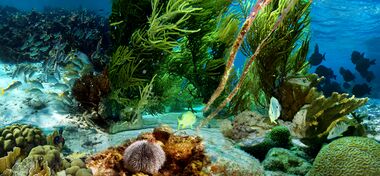
Within this island group:
- Bonaire is part of the ABC islands within the Leeward Antilles island chain off the Venezuelan coast. The Leeward Antilles have a mixed volcanic and coral origin.
- Saba و سنت أوستاتيوس are part of the SSS islands. They are located east of Puerto Rico and the Virgin Islands. Although in the English language they are considered part of the Leeward Islands, French, Spanish, Dutch and the English spoken locally consider them part of the Windward Islands. The Windward Islands are all of volcanic origin and hilly, leaving little ground suitable for agriculture. The highest point is Mount Scenery, 887 m (2,910 ft), on Saba. This is the highest point in the country and is also the highest point of the entire Kingdom of the Netherlands.
The islands of the Caribbean Netherlands enjoy a tropical climate with warm weather all year round. The Leeward Antilles are warmer and drier than the Windward islands. In summer, the Windward Islands can be subject to hurricanes.[بحاجة لمصدر]
الحكومة والسياسة

The Netherlands has been a constitutional monarchy since 1815, and due to the efforts of Johan Rudolph Thorbecke[60] became a parliamentary democracy in 1848. The Netherlands is described as a consociational state. Dutch politics and governance are characterised by an effort to achieve broad consensus on important issues, within both the political community and society as a whole. In 2017, The Economist ranked the Netherlands as the 11th most democratic country in the world.[بحاجة لمصدر]
The monarch is the head of state, at present King Willem-Alexander of the Netherlands. Constitutionally, the position is equipped with limited powers. By law, the King has the right to be periodically briefed and consulted on government affairs. Depending on the personalities and relationships of the King and the ministers, the monarch might have influence beyond the power granted by the Constitution of the Netherlands.[بحاجة لمصدر]
The executive power is formed by the Council of Ministers, the deliberative organ of the Dutch cabinet. The cabinet usually consists of 13 to 16 ministers and a varying number of state secretaries. One to three ministers are ministers without portfolio. The head of government is the Prime Minister of the Netherlands, who often is the leader of the largest party of the coalition. The Prime Minister is a primus inter pares, with no explicit powers beyond those of the other ministers. Mark Rutte has been Prime Minister since October 2010; the Prime Minister had been the leader of the largest party of the governing coalition continuously since 1973.[بحاجة لمصدر]
The cabinet is responsible to the bicameral parliament, the States General, which also has legislative powers. The 150 members of the House of Representatives, the lower house, are elected in direct elections on the basis of party-list proportional representation. These are held every four years, or sooner in case the cabinet falls (for example: when one of the chambers carries a motion of no confidence, the cabinet offers its resignation to the monarch). The provincial assemblies, the States-Provincial, are directly elected every four years as well. The members of the provincial assemblies elect the 75 members of the Senate, the upper house, which has the power to reject laws, but not propose or amend them. Both houses send members to the Benelux Parliament, a consultative council.[بحاجة لمصدر]
الثقافة السياسية
Both trade unions and employers organisations are consulted beforehand in policymaking in the financial, economic and social areas. They meet regularly with the government in the Social-Economic Council. This body advises government and its advice cannot be put aside easily.[بحاجة لمصدر]
The Netherlands has a tradition of social tolerance.[61] In the 18th century, while the Dutch Reformed Church was the state religion, Catholicism, other forms of Protestantism, such as Baptists and Lutherans, as well as Judaism were tolerated but discriminated against.[62]
In the late 19th century this Dutch tradition of religious tolerance transformed into a system of pillarisation, in which religious groups coexisted separately and only interacted at the level of government.[63] This tradition of tolerance influences Dutch criminal justice policies on recreational drugs, prostitution, LGBT rights, euthanasia, and abortion, which are among the most liberal in the world.[بحاجة لمصدر]
الأحزاب السياسية
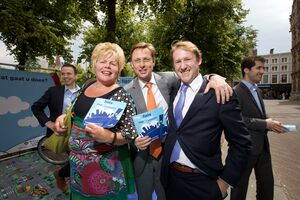
No single party has held a majority in parliament since the 19th century, and as a result, coalition cabinets had to be formed. Since suffrage became universal in 1917, the Dutch political system has been dominated by three families of political parties: Christian Democrats (currently the CDA), Social Democrats (currently the PvdA), and Liberals (currently the VVD).
These parties co-operated in coalition cabinets in which the Christian Democrats had always been a partner: so either a centre-left coalition of the Christian Democrats and Social Democrats was ruling or a centre-right coalition of Christian Democrats and Liberals. In the 1970s, the party system became more volatile: the Christian Democratic parties lost seats, while new parties became successful, such as the radical democrat and progressive liberal Democrats 66 (D66) or the ecologist party GroenLinks (GL).[بحاجة لمصدر]
In the 1994 election, the CDA lost its dominant position. A "purple" cabinet was formed by the VVD, D66, and PvdA. In the 2002 elections, this cabinet lost its majority, because of an increased support for the CDA and the rise of the right-wing LPF, a new political party, around Pim Fortuyn, who was assassinated a week before the elections. A short-lived cabinet was formed by CDA, VVD, and LPF, which was led by the CDA Leader Jan Peter Balkenende. After the 2003 elections, in which the LPF lost most of its seats, a cabinet was formed by the CDA, VVD, and D66. The cabinet initiated an ambitious programme of reforming the welfare state, the healthcare system, and immigration policy.[بحاجة لمصدر]
In June 2006, the cabinet fell after D66 voted in favour of a motion of no confidence against the Minister of Immigration and Integration, Rita Verdonk, who had instigated an investigation of the asylum procedure of Ayaan Hirsi Ali, a VVD MP. A caretaker cabinet was formed by the CDA and VVD, and general elections were held on 22 November 2006. In these elections, the CDA remained the largest party and the Socialist Party made the largest gains. The formation of a new cabinet took three months, resulting in a coalition of CDA, PvdA, and Christian Union.[بحاجة لمصدر]
On 20 February 2010, the cabinet fell when the PvdA refused to prolong the involvement of the Dutch Army in Uruzgan, Afghanistan.[64] Snap elections were held on 9 June 2010, with devastating results for the previously largest party, the CDA, which lost about half of its seats, resulting in 21 seats. The VVD became the largest party with 31 seats, closely followed by the PvdA with 30 seats. The big winner of the 2010 elections was Geert Wilders, whose right wing PVV,[65][66] the ideological successor to the LPF, more than doubled its number of seats.[67] Negotiation talks for a new government resulted in a minority government, led by VVD (a first) in coalition with CDA, which was sworn in on 14 October 2010. This unprecedented minority government was supported by PVV, but proved ultimately to be unstable,[68] when on 21 April 2012, Wilders, leader of PVV, unexpectedly 'torpedoed seven weeks of austerity talks' on new austerity measures, paving the way for early elections.[69][70][71]
VVD and PvdA won a majority in the House of Representatives during the 2012 general election. On 5 November 2012 they formed the second Rutte cabinet. After the 2017 general election, VVD, Christian Democratic Appeal, Democrats 66 and ChristenUnie formed the third Rutte cabinet. This cabinet resigned in January 2021, two months before the general election, after a child welfare fraud scandal.[72] In March 2021, centre-right VVD of Prime Minister Mark Rutte was the winner of the elections, securing 34 out of 150 seats. The second biggest party was the centre-left D66 with 24 seats. Geert Wilders' far-right party lost support. Prime Minister Mark Rutte, in power since 2010, formed his fourth coalition government, the Fourth Rutte cabinet, consisting of the same parties as the previous one.[73]
الحكومة
التقسيمات الإدارية
The Netherlands is divided into twelve provinces, each under a King's Commissioner (Commissaris van de Koning). Informally in Limburg province this position is named Governor (Gouverneur). All provinces are divided into municipalities (gemeenten), of which there are 344 (2022).[74][75]
The country is also subdivided into 21 water districts, governed by a water board (waterschap or hoogheemraadschap), each having authority in matters concerning water management.[76][77] The creation of water boards actually pre-dates that of the nation itself, the first appearing in 1196. The Dutch water boards are among the oldest democratic entities in the world still in existence. Direct elections of the water boards take place every four years.
The administrative structure on the three BES islands, collectively known as the Caribbean Netherlands, is outside the twelve provinces. These islands have the status of openbare lichamen (public bodies).[78] In the Netherlands these administrative units are often referred to as special municipalities.
Within the Dutch town of Baarle-Nassau, are 22 Belgian exclaves[79] and within those are 8 Dutch enclaves.
| ||||||||||||||||||||||||||||||||||||||||||||||||||||||||||||||||||||||||||||||||||||||||||||||||||||||||||||||||
| ||||||||||||||||||||||||||||||
العلاقات الخارجية
The history of Dutch foreign policy has been characterised by its neutrality. Since World War II, the Netherlands has become a member of a large number of international organisations, most prominently the UN, NATO and the EU. The Dutch economy is very open and relies strongly on international trade.[بحاجة لمصدر]
The foreign policy of the Netherlands is based on four basic commitments: to Atlantic co-operation, to European integration, to international development and to international law. One of the more controversial international issues surrounding the Netherlands is its liberal policy towards soft drugs.[بحاجة لمصدر]
During and after the Dutch Golden Age, the Dutch people built up a commercial and colonial empire. The most important colonies were present-day Suriname and Indonesia. Indonesia became independent after the Indonesian National Revolution in the 1940s following a war of independence, international pressure and several United Nations Security Council resolutions. Suriname became independent in 1975. The historical ties inherited from its colonial past still influence the foreign relations of the Netherlands. In addition, many people from these countries are living permanently in the Netherlands.[بحاجة لمصدر]
 مقالة مفصلة: السياسة الخارجية لهولندا
مقالة مفصلة: السياسة الخارجية لهولندا
الأراضي المنخفضة كانت دوماً من الدول السباقة في التعاون الدولي عامةً و الاوروبي خاصةً. كانت عضواً مؤسساً بحلف شمال الأطلسي (الناتو) عام 1949، في المجموعة الاوروبية للفحم و الحديد عام 1951، المجموعة الاقتصادية الاوروبية عام 1957، اتحاد البنلوكس الاقتصادي عام 1958، الاتحاد الاوروبي عام 1993 و أخيراً في تطبيق العملة الأوروبية الموحدة اليورو اللتي دخلت حيز التنفيذ عام 2001. أثار تصرف الجنود الهولنديين اللذين يعملون تحت قيادة الامم المتحدة في البوسنة و الهرسك عام 1995 انتقاداً دولياً، حيث اتهموا بعدم بذل أي جهد لوقف مذبحة الصرب في حق سكان سريبرينيشا المسلمين. الخدمة العسكرية في هولندا ليست اجبارية و تقتطع المصروفات العسكرية 1.5% من الناتج العام للدولة.
يقع مقر محكمة العدل الدولية في لاهاي، ساهمت المحكمة المستقلة في حل العديد من المشاكل الدولية.
تاريخ العلاقات العربية الهولندية
انظر: تاريخ العلاقات العربية الهولندية
العسكرية
The Netherlands has one of the oldest standing armies in Europe; it was first established as such by Maurice of Nassau in the late 1500s. The Dutch army was used throughout the Dutch Empire. After the defeat of Napoleon, the Dutch army was transformed into a conscription army. The army was unsuccessfully deployed during the Belgian Revolution in 1830. After 1830, it was deployed mainly in the Dutch colonies, as the Netherlands remained neutral in European wars (including the First World War), until the Netherlands was invaded in World War II and defeated by the Wehrmacht in May 1940.[بحاجة لمصدر]
The Netherlands abandoned its neutrality in 1948 when it signed the Treaty of Brussels, and became a founding member of NATO in 1949. The Dutch military was therefore part of the NATO strength in Cold War Europe, deploying its army to several bases in Germany. More than 3,000 Dutch soldiers were assigned to the 2nd Infantry Division of the United States Army during the Korean War. In 1996 conscription was suspended, and the Dutch army was once again transformed into a professional army. Since the 1990s the Dutch army has been involved in the Bosnian War and the Kosovo War, it held a province in Iraq after the defeat of Saddam Hussein, and it was engaged in Afghanistan.[بحاجة لمصدر]
The military is composed of four branches, all of which carry the prefix Koninklijke (Royal):
- Koninklijke Marine (KM), the Royal Netherlands Navy, including the Naval Air Service and Marine Corps;
- Koninklijke Landmacht (KL), the Royal Netherlands Army;
- Koninklijke Luchtmacht (KLu), the Royal Netherlands Air Force;
- Koninklijke Marechaussee (KMar), the Royal Marechaussee (Military Police), tasks include military police and border control.
The submarine service opened to women on 1 January 2017. The Korps Commandotroepen, the Special Operations Force of the Netherlands Army, is open to women, but because of the extremely high physical demands for initial training, it is almost impossible for a woman to become a commando.[83] The Dutch Ministry of Defence employs more than 70,000 personnel, including over 20,000 civilians and over 50,000 military personnel.[84] In April 2011 the government announced a major reduction in its military because of a cut in government expenditure, including a decrease in the number of tanks, fighter aircraft, naval ships and senior officials.[85]
The Netherlands has ratified many international conventions concerning war law. The Netherlands decided not to sign the UN treaty on the Prohibition of Nuclear Weapons.[86]
السكان

 مقالة مفصلة: ديموغرافيا هولندا
مقالة مفصلة: ديموغرافيا هولندا
تعد هولندا أحد أكثر دول العالم كثافةً بالسكان، حيث يبلغ عدد السكان حوالي 16 مليون نسمة بمساحة كاملة تبلغ حوالي 41 ألف كم، ناتجاً عن ذللك كثافة سكانية بلغ مقدارها عام 2003: 389 نسمة/كم مربع. هولندا من أكثر مناطق غربي اوروبا ازدحاماً بالسكان، بل من أكثف مناطق العالم ، والهولنديون من أكثر غرب أوروبا تناسلا وحوالي نصف سكان هولندا يعيشون في المنطقتين الغربيتين ، هولندا الشمالية وهولندا الجنوبية ، وبهما المدن الهامة ، امستردام ، وروتردام ،و لاهاى ، وأوترخت، ويسمي بنطاق (الرانستاد ) وهاجر عدد كبير من سكان هولندا إلى العالم الجديد ، ولقد هاجرت إليها أعداد كبيرة من الأيدي العاملة من الخارج ومن البلدان الإسلامية في الآونة الأخيرة . هولندا بلد زراعي صناعي ، فحوالي 70% من أرضها استغلت في الزراعة ، والرعي و نظراً لاستخدام الآلات فلا يعمل بالزراعة غير 6% من القوي العاملة في هولندا ، والحاصلات تتمثل في البطاطس والجودار والشوفان والقمح والشعير وبنجر السكر ،والخضر والعنب ، ولها شهرة عالمية في انتاج الزهور ، ولقد انتشرت بهولندا مزارع البيوت الزجاجية، وللثروة الحيوانية قيمتها في الاقتصاد الهولندي ، ولها شهرتها العالمية في إنتاج اللحوم والألبان بكميات تفوق حاجتها وتصدر ،ولصيد الأسماك وتعبئتها نفس القيمة وخصوصاً الأسماك النادرة كالرنجة والتونة ، وهولندا فقيرة في الموارد المعدنية ومواد الطاقة، وتوجد بها كميات من النفط والغاز الطبيعي لاتكفي حاجتها ، وبرغم هذا تحولت إلى دولة صناعية هامة ، ومن أشهر الصناعات صناعة المنسوجات الصوفية والقطنية والصناعات الغذائية ، وتعليب وحفظ الأسماك ، ومن الصناعات الثقيلة بناء السفن ، والآلات الميكانكية والهندسية ، والصناعات البتروكيميائية والآلات الكهربائية والالكترونيات .
اللغة
 مقالة مفصلة: اللغة الهولندية
مقالة مفصلة: اللغة الهولندية
الهولندية هي اللغة الرسمية في الدول كلها، إلى جانب اللغة الفريزية اللتي تستعمل في مقاطعة فريزنلاند. أيضاً تُحكى الألمانية السفلى في الشمال الشرقي و الألمانية الفصحى في الجنوب الشرقي من البلاد. هناك خطأ شائع بأن اللغة الهولندية (بالانجليزية: Dutch) هي نفسها اللغة الألمانية (بالألمانية: Deutsch)، ولكن هذا غير صحيح هم فقط متقاربتين لغوياً.
الديانة
 مقالة مفصلة: الدين في هولندا
مقالة مفصلة: الدين في هولندا
أهم أديان المملكة هم الكاثوليكية (31%)، البروتستانتينية (21%) و الاسلام (5.5%). معظم البروتستانت يتبعون الكنيسة الكالفانية، بينما يُشكل المهاجرون معظم المسلمين. 40% من الهولندين لا يتبعون أي ديانة. السكان الكاثوليك يقطنون المناطق الجنوبية بينما يعيش البروتستانت في الشمال.
الأعياد والعطل
الأعياد الدينية هي رأس السنة الميلادية (الأول من كانون الثاني/يناير)، عيد الفصح، عيد الصعود، عيد العنصرة، يوم نيقولا (5 كانون الأول/ديسمبر) و ليلة و عيد الميلاد المجيد (24-26 كانون الأول/ديسمبر). الاعياد الوطنية هي يوم الملكة (30 نيسان/ابريل)، يوم الحداد على ضحايا الحرب العالمية الثانية (4 أيار/مايو) ، يوم التحرير من النازيين (5 أيار/مايو)
السياسة
 مقالة مفصلة: سياسة هولندا
مقالة مفصلة: سياسة هولندا
النظام السياسي
الأراضي المنخفضة هي دولة ملكية ودستورية.الدستور يمنح الملك سلطة محدودة ومقر الحكومة في لاهاي. يرأس الحكومة رئيس الوزراء الذي يتم تعينه عن طريق الملك اعتماداً على نتائج البرلمان (Staten-Generaal). يتكون البرلمان من مجلسين: الاول يتكون من 75 عضوا والثاني يتكون من 150 عضوا، كل مجلس برلماني يوافق على القوانين المقترحة أو يرفضها كما يقوم العاهل الهولندي بتعين جميع قضاة الدولة مدى الحياة . أعلى المحاكم الهولندية هي المحكمة العليا. أهم الأحزاب السياسية: النداء الديمقراطي المسيحي (CDA)، حزب العمل (PvdA)، حزب الشعب للحرية و الديمقراطية (VVD)، الحزب الاشتراكي (SP) و قائمة بيم فورتين (LPF) .
التقسيمات الادارية
 مقالة مفصلة: التقسيمات الادارية لهولندا
مقالة مفصلة: التقسيمات الادارية لهولندا
مملكة الأراضي المنخفضة هي اتحاد بين الأراضي المنخفضة (هولندا)، الأنتيل الهولندية و أروبا. الاخيرتان هم عبارة عن جزر في البحر الكاريبي.
هولندا تنقسم إلى 12 مقاطعة (بالهولندي: provincies)، اللذين بدورهم ينقسموا إلى 483 بلدية محلية (gemeenten). العاصمة وأكبر مدينة هي أمستردام (793,000 نسمة في 2004)، أهم المدن الأخرى: روتردام (600,000 نسمة في 2004)، لاهاي (469,570 نسمة في 2003)، أوتريخت (265,000 نسمة في 2003) غرونينغن (179,400 نسمة في 2004)، أرنهايم (141,500 نسمة في 2003) و ماسترخت (122,000 نسمة في 2003) و ايندهوفن مقر شركة فيليپس للإلكترونيات.
أكبر 10 مدن
الاقتصاد
 مقالة مفصلة: اقتصاد هولندا
مقالة مفصلة: اقتصاد هولندا
على غير الدول الاوروبية الأخرى فإن اقتصاد هولندا مستقر و يتمتع بنسبة بطالة منخفضة. أهم صناعات البلاد هي المواد الغذائية، الصناعات الكيمائية، الصناعات الكهربائية و تكرير النفط. لدى هولندا ثروة زراعية متقدمة، فإلى جانب الخضراوات، الفاكهة، الحبوب، تُزرع أيضاً الأزهار و الورود و خاصة أزهار الخُزامى (التوليب)، جاعلةً من البلاد أحد أكبر مصدري الورود في العالم. الجبنة الهولندية هي أحد أهم صادرات البلاد. هولندا تُعد، بعد الولايات المتحدة و فرنسا، ثالث أكبر مُصدر زراعي بالعالم . لدى هولندا احتياطات غاز طبيعي قريبة من غرونيغن و في بحر الشمال. ( انظر : المرض الهولندي "مصطلح حالة اقتصادية" ).
لدى هولندا ما مجموعه 2,809 كم من السكك الحديدية ، 125,575 كم من الطرق البرية و 5046 كم من الطرق الملاحية حسب احصاءات عام 2001. أهم موانئ البلاد: روتردام، أمستردام و هارلم. ميناء روتردام هو أكبر ميناء في أوروبا و ثاني أكبر ميناء في العالم بعد شنغهاي. مطار شيفول الدولي، الواقع في جنوب العاصمة هو أكبر مطارات البلاد ال 19 . كيه ال ام (KLM) هي شركة الطيران الرسمية و أحد أهم الخطوط الجوية في أوروبا . خدمة السكك و القطارات تُدار بشكل رئيسي من شركة القطارات الهولندية (Nederlandse Spoorwegen) تملك معظمها الدولة. توجد خدمة قطار الأنفاق (مترو) في معظم المدن الكبرى. الملاحة البحرية و النهرية تُشكل عامل مهم في حركة المواصلات بالبلاد لكثرة القنوات و الأنهر و مع الدول المجاورة و خاصة بريطانيا و ألمانيا.
الثقافة والتعليم
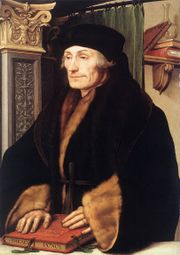
عاشت هولندا نهضة علمية و ثقافية في القرن السابع عشر. أهم رواد هذه الفترة في الأدب: يوست ڤان دن ڤوندل (van den Vondel) و بي سي هوفت (Hooft). هولندا هي موطن الرسامين العالميين التالين: رمبرانت (Rembrandt)، يوهانس ڤرمير (Vermeer)، فنسنت فان كوخ (van Gogh)، پيت موندريان (Mondriaan) و ام سي إشر (Escher) و الفلاسفة إرازموس الروتردامي (Erasmus) و باروخ سپينوزا (Spinoza). العالم الهولندي رودولف شتاينمتس (Steinmetz) أضاف الكثير إلى علم الاجتماع.
ينقسم نظام التعليم الهولندي إلى الأقسام التالية:
- التعليم الابتدائي (bo - Basis Onderwijs)
- التعليم الثانوي (vo - Voortgezet Onderwijs)
- التعليم المهني (bve - Beroepsonderwijs en Volwasseneneducatie)
- التعليم الجامعي الأساسي (البكالوريوس) (hbo - Hoger Beroeps Onderwijs)
- التعليم الجامعي العالي (ماستر) (wo - Wetenschappelijk Onderwijs)
أهم جامعات البلاد: جامعة إرازموس في روتردام، جامعة دلفت التقنية، معهد لاهاي للقانون الدولي و جامعة أمستردام وجامعة انهولاند التي لها فروع في معظم مدن البلاد وخصوصا مدينة روتردام ومدينة لاهاي أو Den Haag .
يعتبر نظام التعليم لديهم من أكثر الأنظمة تطورا على مستوى العالم و من أهم مميزاته الإستقلالية الكاملة التي تتمتع بها كل مدرسة إلى جانب حريتها في إختيار مناهجها ولكن ضمن ما تسمح به قوانين وزارة التربية لديهم، وتعتبر هولندا من الدول السباقة والرائدة في عملية توظيف التكنولوجيا في التعليم (ICT).
العسكرية
الزراعة والبستنه
ملاحظات
- ^ أ ب Amsterdam is the constitutional capital, while the government and the royal family are seated in The Hague.
- ^ عدا الهولندية، فالإنگليزية هي اللغة الرسمية في البلديات الخاصة سابا وسنت أوستاتيوس، پاپيامنتو هي لغة رسمية في البلدية الخاصة بونير، والفريزية الغربية هي لغة رسمية في مقاطعة فريزلاند.[1]
- ^ لكونها قد صدقت على الميثاق الأوروپي للغات الأقاليم والأقليات في 1996، فإن الحكومة الهولندية تعترف بالساكسونية السفلى الهولندية، والليمبورگش وسنته روماني واليديش كلغات أقاليم أو أقليات غير إقليمية.[1] في 1 يوليو 2021، حصلت لغة الإشارة الهولندية على وضع لغة معترف بها.[2]
- ^ Excluding people with a Turkish background, who are included separately in this table.
- ^ The euro is used in the European part of the Netherlands and replaced the Dutch guilder in 2002. The United States dollar is used في هولندا الكاريبية وحل محل گيلدر الأنتيل الهولندية in 2011.[11]
- ^ CET and CEST are used in the European Netherlands, and AST is used في هولندا الكاريبية.
- ^ +599 was the country code designated for the now dissolved الأنتيل الهولندية. The Caribbean Netherlands still use +599 7 (لبونير)، +599 3 (لسنت أوستاتيوس)، و +599 4 (لسابا).
- ^ .nl is the common internet top level domain name for the Netherlands. The .eu domain is also used, as it is shared with other الاتحاد الأوروبي member states. .bq is designated, but not in use, for the هولندا الكاريبية.
الهامش
- ^ أ ب ت ث ج "Welke erkende talen heeft Nederland?" (in الهولندية). Rijksoverheid. 11 January 2016. Retrieved 27 December 2017.
- ^ أ ب "Besluit van 24 juni 2021 tot vaststelling van het tijdstip van inwerkingtreding van de Wet erkenning Nederlandse Gebarentaal" (PDF). Staatsblad van Het Koninkrijk der Nederlanden. 2021. ISSN 0920-2064. Retrieved 1 July 2021.
- ^ "CBS Statline". opendata.cbs.nl. Retrieved 2 April 2021.
- ^ CBS. "What are the major religions?". www.cbs.nl (in الإنجليزية). Retrieved 2022-09-15.
- ^ "CIA factbook Netherlands". CIA. Retrieved 26 July 2021.
- ^ "Bevolkingsteller". Statistics Netherlands (in Dutch). Retrieved 9 June 2021.
{{cite web}}: CS1 maint: unrecognized language (link) - ^ "Dutch Census 2011 Analysis and Methodology" (PDF). Statistics Netherlands. 19 November 2014. p. 9. Retrieved 9 June 2021.
- ^ أ ب ت ث "World Economic Outlook Database, April 2022". IMF.org. International Monetary Fund. April 2022. Retrieved April 19, 2022.
- ^ "Gini coefficient of equivalised disposable income – EU-SILC survey". ec.europa.eu. Eurostat. Retrieved 21 June 2022.
- ^ "Human Development Report 2021/2022" (PDF) (in الإنجليزية). United Nations Development Programme. 8 September 2022. Retrieved 8 September 2022.
- ^ "Wet geldstelsel BES". Dutch government. 30 September 2010. Retrieved 11 January 2014.
- ^ "Dutch government ditches Holland to rebrand as the Netherlands". the Guardian (in الإنجليزية). 2019-10-04. Retrieved 2022-06-01.
- ^ "Netherlands vs. Holland". Netherlands Bureau for Tourism and Congresses. 18 October 2012. Retrieved 3 December 2019.
{{cite web}}: CS1 maint: url-status (link) - ^ "Holland". WorldAtlas. worldatlas.com. 13 April 2021. Retrieved 18 May 2021.
- ^ "North Sea". Ministry of Defence. Retrieved 6 March 2012.
- ^ Dutch Ministry of Foreign affairs. "About the Nederlands". Retrieved 3 March 2011.
- ^ "Gemeentegrootte en stedelijkheid" (in الهولندية). CBS. Retrieved 16 December 2019.
- ^ Dutch Wikisource. "Grondwet voor het Koninkrijk der Nederlanden" [Constitution for the Kingdom of the Netherlands] (in الهولندية). Chapter 2, Article 32. Retrieved 3 July 2013.
... de hoofdstad Amsterdam ...
- ^ Permanent Mission of the Netherlands to the UN. "General Information". Archived from the original on 5 October 2013. Retrieved 26 June 2013.
- ^ "Rotterdam: the largest freight port in the EU", European Commission, 2 April 2020, https://ec.europa.eu/eurostat/web/products-eurostat-news/-/ddn-20200402-2, retrieved on 25 November 2021
- ^ van Krieken, Peter J.; David McKay (2005). The Hague: Legal Capital of the World. Cambridge University Press. ISBN 978-90-6704-185-0., specifically, "في عقد 1990، أثناء مدته كأمين عام للأمم المتحدة، بدأ بطرس بطرس غالي في تسمية لاهاي عاصمة العالم القانونية."
- ^ خطأ استشهاد: وسم
<ref>غير صحيح؛ لا نص تم توفيره للمراجع المسماة:1 - ^ How it Works: Science and Technology. Marshall Cavendish. 2003. p. 1208. ISBN 978-0-7614-7323-7.
- ^ "Netherlands - Dutch civilization in the Golden Age (1609–1713)". Encyclopedia Britannica (in الإنجليزية). Retrieved 10 November 2021.
- ^ "Dutch Republic | History & Facts". Encyclopedia Britannica (in الإنجليزية). Retrieved 10 November 2021.
- ^ "HISTORY OF THE DUTCH EMPIRE". www.historyworld.net. Retrieved 10 November 2021.
- ^ "Netherlands: Agricultural exports top 80 billion Euros". Archived from the original on 22 January 2015. Retrieved 25 January 2015.
- ^ (RVO), Netherlands Enterprise Agency (17 July 2015). "Agriculture and food". hollandtrade.com. Retrieved 26 August 2016.
- ^ "How the Netherlands Feeds the World". National Geographic Society. September 2017. Retrieved 15 January 2020.
- ^ "World Economic Outlook Database, October 2019". World Economic Outlook. International Monetary Fund. October 2019. Retrieved 1 January 2020.
- ^ "2016 World Press Freedom Index – RSF". Rsf.org. 1 February 2017. Archived from the original on 1 February 2017.
{{cite web}}: CS1 maint: bot: original URL status unknown (link) - ^ "Netherlands". Archived from the original on 10 May 2013. Retrieved 10 May 2013.
{{cite web}}: CS1 maint: bot: original URL status unknown (link), Index of Economic Freedom. heritage.org. - ^ Human Development Report 2021 (PDF). New York: United Nations Development Programme. 2021. p. 24. Retrieved 28 April 2021.
- ^ "World Happiness Report". worldhappiness.report (in الإنجليزية). Retrieved 28 April 2021.
- ^ "Franks". Columbia Encyclopedia. Columbia University Press. 2013. Retrieved 1 February 2014.
- ^ "Lotharingia / Lorraine (Lothringen)". 5 September 2013. Retrieved 1 February 2014.
- ^ Wim Blockmans; Walter Prevenier (3 August 2010). The Promised Lands: The Low Countries Under Burgundian Rule, 1369–1530. University of Pennsylvania Press. pp. 85–. ISBN 978-0-8122-0070-6.
- ^ Elton, Geoffrey Rudolph (1990). The New Cambridge Modern History: Volume 2, The Reformation, 1520–1559. ISBN 978-0-521-34536-1.
- ^ Van der Lem, Anton. "De Opstand in de Nederlanden 1555–1609;De landen van herwaarts over". Retrieved 11 March 2013.
- ^ https://www.holland.com/be_nl/toerisme/informatie/algemeen/nederland-vs-holland.htm "Wat is het verschil tussen Holland en Nederland? Nederland bestaat uit de 12 provincies, maar veel mensen gebruiken ook het woord Holland als ze het over Nederland hebben."
- ^ "Telegraph style book: places and peoples". The Daily Telegraph. London. 12 April 2008. Retrieved 31 March 2014.
- ^ "The BBC News Styleguide" (PDF). Archived from the original (PDF) on 27 February 2012. Retrieved 31 March 2014.
- ^ Welschen, Ad: Course Dutch Society and Culture, International School for Humanities and Social Studies ISHSS, Universiteit van Amsterdam, 2000–2005.
- ^ Wong, Th.E.; Batjes, D.A.J.; Jager, J. de (2007). Geology of the Netherlands. KNAW. ISBN 978-90-6984-481-7.
- ^ Zuiderzee floods (Netherlands history). Britannica Online Encyclopedia.
- ^ Duplessis, Robert S. (1997) Transitions to Capitalism in Early Modern Europe, Cambridge University Press, ISBN 978-0-521-39773-5
- ^ "Windmills in Dutch History". Let.rug.nl. Rijks Universiteit Groningen. Archived from the original on 5 July 2017. Retrieved 7 July 2017.
- ^ "Kerngegevens gemeente Wieringermeer". sdu.nl. Archived from the original on 6 January 2008. Retrieved 21 January 2008.
- ^ "Kerngegevens procincie Flevoland". sdu.nl. Archived from the original on 26 December 2007. Retrieved 21 January 2008.
- ^ Nickerson, Colin (5 December 2005). "Netherlands relinquishes some of itself to the waters". Boston Globe. Archived from the original on 30 June 2006. Retrieved 10 October 2007.
- ^ Olsthoorn, A.A.; Richard S.J. Tol (February 2001). Floods, flood management and climate change in The Netherlands. Institute for Environmental Studies, Vrije Universiteit. OCLC 150386158. Archived from the original on 22 October 2007. Retrieved 10 October 2007.
- ^ Tol, Richard S. J.; van der Grijp, Nicolien; Olsthoorn, Alexander A.; van der Werff, Peter E. (2003). "Adapting to Climate: A Case Study on Riverine Flood Risks in the Netherlands" (PDF). Risk Analysis. 23 (3): 575–583. doi:10.1111/1539-6924.00338. hdl:1871/31872. PMID 12836850. S2CID 1054016.
- ^ Seven Wonders Archived 2 أغسطس 2010 at the Wayback Machine. Asce.org (19 July 2010). Retrieved on 21 August 2012.
- ^ Kimmelman, Michael (13 February 2013). "Going With the Flow". The New York Times. Archived from the original on 14 February 2013. Retrieved 19 February 2013.
- ^ Dinerstein, Eric; et al. (2017). "An Ecoregion-Based Approach to Protecting Half the Terrestrial Realm". BioScience. 67 (6): 534–545. doi:10.1093/biosci/bix014. ISSN 0006-3568. PMC 5451287. PMID 28608869.
- ^ "Beekbergerwoud - Natuurgebied". Natuurmonumenten (in الهولندية). Retrieved 2022-06-13.
- ^ Grantham, H. S.; et al. (2020). "Anthropogenic modification of forests means only 40% of remaining forests have high ecosystem integrity - Supplementary Material". Nature Communications. 11 (1): 5978. doi:10.1038/s41467-020-19493-3. ISSN 2041-1723. PMC 7723057. PMID 33293507.
- ^ Malo, Paul (18 November 2019). "Les insectes sont bel et bien en train de disparaître" [Insects are well and truly disappearing]. www.consoglobe.com (in الفرنسية).
- ^ "Maritime boundaries of the Caribbean part of the Kingdom". Ministry of Defence (in الإنجليزية). 15 November 2017. Retrieved 5 August 2020.
- ^ Stevens, Harm (13 March 1998). "Een stijf Hollands heertje". NRC Handelsblad (in الهولندية). Retrieved 11 November 2018.
- ^ Buruma, Ybo (2007). "Dutch Tolerance: On Drugs, Prostitution, and Euthanasia". Crime and Justice. 35 (1): 73–113. doi:10.1086/650185. ISSN 0192-3234. JSTOR 10.1086/650185. S2CID 144295342.
- ^ Israel, Jonathan (1995). The Dutch Republic: Its Rise, Greatness and Fall, 1477–1806. Oxford History of Early Modern Europe. ISBN 0-19-873072-1.
- ^ Kaplan, Benjamin J. (2019-09-05). "Dutch" Religious Tolerance: Celebration and Revision (in الإنجليزية). Brill. ISBN 978-90-04-35395-4.
- ^ Dirks, Bart & Koelé, Theo (20 February 2010). "Kabinet valt over Uruzgan-besluit". De Volkskrant (in الهولندية). Archived from the original on 23 February 2010. Retrieved 20 February 2010.
- ^ "Dutch Parliamentary Elections: Will Far-Right Freedom Party Defy Polls Again?". International Business Times. 12 September 2012. Retrieved 26 March 2013.
- ^ Castle, Stephen; Erlanger, Steven. "Times Topics: Geert Wilders". The New York Times. Retrieved 26 March 2013.
- ^ "Lengthy coalition talks loom after far-right gain in Dutch elections". France24. 10 June 2010. Retrieved 12 June 2010.
- ^ "Neue niederländische Regierung formiert sich". Der Spiegel (in الألمانية). 8 October 2010.
- ^ Corder, Mike (21 April 2012). "Dutch prime minister says government austerity talks collapse". The Washington Post. Associated Press. Archived from the original on 10 July 2012. Retrieved 21 April 2012.
- ^ Wearden, Graeme (23 April 2012). "Dutch prime minister lays blame squarely with Geert Wilders". The Guardian. London.
- ^ "Dutch prime minister says austerity talks collapse". NWADG. The Associated Press. 21 April 2012. Retrieved 12 March 2017.
- ^ "Dutch government resigns over child benefits scandal". Financial Times. 16 January 2021. Retrieved 16 January 2021.
- ^ "Dutch election: PM Mark Rutte claims victory and fourth term". BBC News. 18 March 2021.
- ^ "Gemeentelijke indeling op 1 januari 2021" [Municipalities on 1 January 2021]. CBS Classifications (in الهولندية). CBS. Retrieved 23 March 2021.
- ^ "Gemeentelijke indeling op 1 januari 2019" [Municipalities on 1 January 2019]. CBS Classifications (in الهولندية). CBS. 1 January 2019. Retrieved 7 February 2020.
- ^ "De waterschappen" (in الهولندية). Archived from the original on 3 November 2013. Retrieved 7 June 2013.
- ^ "Mijn waterschap" (in الهولندية). Retrieved 6 May 2021.
- ^ "31.954, Wet openbare lichamen Bonaire, Sint Eustatius en Saba" (in الهولندية). Eerste kamer der Staten-Generaal. Retrieved 15 October 2010.
De openbare lichamen vallen rechtstreeks onder het Rijk omdat zij geen deel uitmaken van een provincie.
"Through the establishment of the BES islands as public bodies, rather than communities, the BES islands' rules may deviate from the rules in the European part of the Netherlands. The Dutch legislation will be introduced gradually. The public bodies fall directly under the central government because they are not part of a province." - ^ "Baarle-Hertog and Baarle Nassau". Exclave.eu. Retrieved 21 November 2016.
- ^ "Oppervlakte".
- ^ "Bevolkingsontwikkeling; regio per maand". Statistics Netherlands (in Dutch). Retrieved 9 June 2021.
{{cite web}}: CS1 maint: unrecognized language (link) - ^ أ ب Ministerie van Algemene Zaken (19 May 2015). "Waaruit bestaat het Koninkrijk der Nederlanden?". Rijksoverheid.
- ^ KCT. Official website of the Dutch Commando Foundation Archived 5 فبراير 2011 at the Wayback Machine. Korpscommandotroepen.nl (14 April 2010). Retrieved on 21 August 2012.
- ^ "Ministerie van defensie – Werken bij Defensie". Mindef.nl. Archived from the original on 11 August 2011. Retrieved 29 April 2010.
- ^ "Defensie hard getroffen door bezuinigingen". Ministry of Defence. Archived from the original on 7 August 2011. Retrieved 26 April 2011.
- ^ "Red Cross urges Netherlands to sign UN nuclear weapons ban". NL Times. 11 February 2019.
وصلات خارجية
- CS1 الهولندية-language sources (nl)
- CS1 maint: url-status
- CS1 maint: bot: original URL status unknown
- CS1 الفرنسية-language sources (fr)
- CS1 الألمانية-language sources (de)
- Short description is different from Wikidata
- Missing redirects
- Articles containing هولندية-language text
- Articles containing فرنسية-language text
- Articles containing إنگليزية-language text
- Articles with hatnote templates targeting a nonexistent page
- Articles with unsourced statements from July 2022
- Articles with broken excerpts
- Articles with unsourced statements from January 2009
- Pages using multiple image with auto scaled images
- هولندا
- مملكة هولندا
- ملكيات دستورية
- بلدان تتحدث الهولندية
- ديمقراطيات ليبرالية
- Member states of the Council of Europe
- بلدان وأقاليم ناطقة بالهولندية
- Germanic countries and territories
- Kingdom of the Netherlands
- Northwestern European countries
- Countries in Europe
- Member states of NATO
- States and territories established in 1815
- Transcontinental countries



